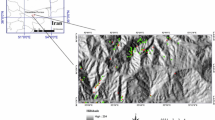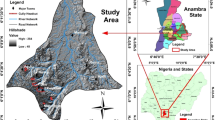Abstract
The current research presents landslide susceptibility mapping by frequency ratio (FR) and weights of evidence (WoE) models based on geographic information system (GIS) and an assessment of their performances for the Shangzhou District of Shangluo City, China. Firstly, landslide locations of the study area were detected using aerial photographs as well as by carrying outfield survey. Then, a total of 145 landslides were mapped out of which 101 (70 % landslide locations) were randomly selected for training the models, and the remaining 44 (30 % landslide locations) were used for validating the models. The following ten landslide conditioning factors, such as slope aspect, curvature, slope angle, elevation, distance to rivers, distance to faults, lithology, peak ground acceleration, distance to roads and precipitation, were considered in this study. Subsequently, landslide susceptibility maps were produced using FR and WoE models in ArcGIS 10.0 software. The validation of landslide susceptibility maps were carried out using areas under the curve. The validation results showed that the training accuracy were 0.7635 (76.35 %) and 0.7450 (74.50 %) for the FR and WoE models, with predictive accuracy 0.7395 (73.95 %) and 0.7102 (71.02 %), respectively, indicating that landslide susceptibility mapping using FR model is more accurate than WoE model for the study area.






Similar content being viewed by others
References
Akgun A (2012) A comparison of landslide susceptibility maps produced by logistic regression, multi-criteria decision, and likelihood ratio methods: a case study at İzmir, Turkey. Landslides 9:93–106
Ayalew L, Yamagishi H (2005) The application of GIS-based logistic regression for landslide susceptibility mapping in the Kakuda Yahiko Mountains, Central Japan. Geomorphology 65:15–31
Bonham-Carter GF (1994) Geographic information systems for geoscientists: modeling with GIS. In: Bonham-Carter F (ed) Computer methods in the geosciences. Pergamon, Oxford
Bui DT, Lofman O, Revhaug I, Dick O (2011) Landslide susceptibility analysis in the Hoa Binh province of Vietnam using statistical index and logistic regression. Nat Hazards 59:1413–1444
C.H. of China geological environment information site (CIGEM) (2013). http://www.cigem.gov.cn/
Chen W, Li WP, Hou EK, Zhao Z, Deng ND, Bai HY, Wang DZ (2014) Landslide susceptibility mapping based on GIS and information value model for the Chencang District of Baoji, China. Arab J Geosci 7:4499–4511
Chen W, Li WP, Hou EK, Bai HY, Chai HC, Wang DZ, Cui XL, Wang QQ (2015) Application of frequency ratio, statistical index, and index of entropy models and their comparison in landslide susceptibility mapping for the Baozhong Region of Baoji, China. Arab J Geosci 8:1829–1841
Dahal RK, Hasegawa S, Nonomura A, Yamanaka M, Masuda T, Nishino K (2008) GIS-based weights-of-evidence modelling of rainfall-induced landslides in small catchments for landslide susceptibility mapping. Environ Geol 54(2):311–324
Devkota KC, Regmi AD, Pourghasemi HR, Yoshida K, Pradhan B, Ryu IC, Dhital MR, Althuwaynee OF (2013) Landslide susceptibility mapping using certainty factor, index of entropy and logistic regression models in GIS and their comparison at Mugling-Narayanghat road section in Nepal Himalaya. Nat Hazards 65:135–165
Einstein HH (1988) Special lecture: landslides risk assessment procedure. In: Proceedings of 5th symposium on landslides, Lausanne, vol 2, pp 1075–1090
Ercanoglu M, Gokceoglu C (2004) Use of fuzzy relation to produce landslide susceptibility map of a landslide prone area (West Black Sea Region, Turkey). Eng Geol 75:229–250
Fell R, Corominas J, Bonnard C, Cascini L, Leroi E, Savage WZ (2008) Guidelines for landslide susceptibility, hazard and risk zoning for land use planning. Eng Geol 102:85–98
Grozavu A, Plescan S, Patriche CV, Margarint MC, Rosca B (2013) Landslide susceptibility assessment: GIS application to a complex mountainous environment. In: The Carpathians: integrating nature and society towards sustainability, environmental science and engineering, pp 31-44
Kundu S, Saha AK, Sharma DC, Pant CC (2013) Remote sensing and GIS based landslide susceptibility assessment using binary logistic regression model: a case study in the Ganeshganga Watershed, Himalayas. J Indian Soc Remote Sens 41(3):697–709
Lee S, Min K (2001) Statistical analyses of landslide susceptibility at Yongin, Korea. Environ Geol 40:1095–1113
Lee S, Talib JA (2005) Probabilistic landslide susceptibility and factor effect analysis. Environ Geol 47:982–990
Nefeslioglu HA, Gokceoglu C, Sonmez H (2008) An assessment on the use of logistic regression and artificial neural networks with different sampling strategies for the preparation of landslide susceptibility maps. Eng Geol 97:171–191
Neuhuser B, Terhorst B (2007) Landslide susceptibility assessment using “weights-of-evidence” applied to a study area at the Jurassic escarpment (SW-Germany). Geomorphology 86(1–2):12–24
Oh HJ, Pradhan B (2011) Application of a neuro-fuzzy model to landslide-susceptibility mapping for shallow landslides in a tropical hilly area. Comput Geosci 37(9):1264–1276
Ozdemir A, Altural T (2013) A comparative study of frequency ratio, weights of evidence and logistic regression methods for landslide susceptibility mapping: Sultan Mountains, SW Turkey. J Asian Earth Sci 64:180–197
Park S, Choi C, Kim B, Kim J (2013) Landslide susceptibility mapping using frequency ratio, analytic hierarchy process, logistic regression, and artificial neural network methods at the Inje area, Korea. Environ Earth Sci 68:1443–1464
Pourghasemi HR, Moradi HR, Fatemi Aghda SM (2013a) Landslide susceptibility mapping by binary logistic regression, analytical hierarchy process, and statistical index models and assessment of their performances. Nat Hazards 69:749–779
Pourghasemi HR, Pradhan B, Gokceoglu C, Deylami Moezzi K (2013b) A comparative assessment of prediction capabilities of Dempster–Shafer and weights-of-evidence models in landslide susceptibility mapping using GIS. Geomat Nat Hazards Risk 4(2):93–118
Pourghasemi HR, Pradhan B, Gokceoglu C, Mohammadi M, Moradi HR (2013c) Application of weights-of-evidence and certainty factor models and their comparison in landslide susceptibility mapping at Haraz watershed, Iran. Arab J Geosci 6:2351–2365
Pradhan B (2010) Landslide susceptibility mapping of a catchment area using frequency ratio, fuzzy logic and multivariate logistic regression approaches. J Indian Soc Remote Sens 38(2):301–320
Pradhan B, Lee S (2009) Landslide risk analysis using artificial neural network model focusing on different training sites. Int J Phys Sci 3(11):1–15
Pradhan B, Oh HJ, Buchroithner M (2010) Weights-of-evidence model applied to landslide susceptibility mapping in a tropical hilly area. Geomat Nat Hazards Risk 1(3):199–223
Regmi NR, Giardino JR, Vitek JD (2010) Modeling susceptibility to landslides using the weight of evidence approach: Western Colorado, USA. Geomorphology 115:172–187
Regmi AD, Devkota KC, Yoshida K, Pradhan B, Pourghasemi HR, Kumamoto T, Akgun A (2014) Application of frequency ratio, statistical index, and weights-of-evidence models and their comparison in landslide susceptibility mapping in Central Nepal Himalaya. Arab J Geosci 7(2):725–742
Soeters R, van Westen CJ (1996) Slope stability recognition analysis and zonation. In: Turner AK, Schuster RL (eds) Landslides: investigation and mitigation, transportation research board special report 247. National Academy Press, Washington, pp 129–177
Solaimani K, Mousavi SZ, Kavian A (2013) Landslide susceptibility mapping based on frequency ratio and logistic regression models. Arab J Geosci 6:2557–2569
Wang HB, Sassa K (2005) Comparative evaluation of landslide susceptibility in Minamata area, Japan. Environ Geol 47:956–966
Wieczorek GF (1984) Preparing a detailed landslide-inventory map for hazard evaluation and reduction. Bull Assoc Eng Geol 21(3):337–342
Xu C, Xu XW, Dai FC, Saraf Arun K (2012) Comparison of different models for susceptibility mapping of earthquake triggered landslides related with the 2008 Wenchuan earthquake in China. Comput Geosci 46:317–329
Acknowledgments
The authors want to show their gratitude to reviewers and editors for their valuable comments which were very useful in bringing the manuscript into the present form.
Author information
Authors and Affiliations
Corresponding author
Rights and permissions
About this article
Cite this article
Chen, W., Ding, X., Zhao, R. et al. Application of frequency ratio and weights of evidence models in landslide susceptibility mapping for the Shangzhou District of Shangluo City, China. Environ Earth Sci 75, 64 (2016). https://doi.org/10.1007/s12665-015-4829-1
Received:
Accepted:
Published:
DOI: https://doi.org/10.1007/s12665-015-4829-1




